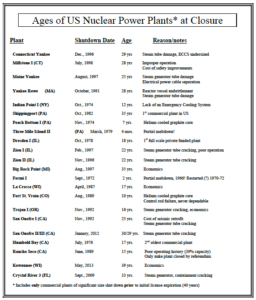Though nuclear plants are theoretically engineered to operate safely for 40 years—their initial permit life—our analysis of the overall record of US first generation commercial nuclear plants shows that almost two dozen reactors were shut down long before their initial license/design life expired.

Among plants built before 1973, fully HALF did not make it to 40 years, or much beyond that, before closing down. Some of these shutdowns were for economic reasons, but in most cases the plants simply wore out, broke down, or never functioned properly. This record of failure can be viewed in our plant closure chart.
In addition to normal industrial wear-and-tear, nuclear plants have the unique and often irreparable liability of having their components continually exposed to varying levels of radiation. Over time, radiation embrittles and/or corrodes the infrastructure (metal components in particular) and will eventually lead to structural failure (hopefully not catastrophic!)
The most common point of failure occurs in the steam generators. Nuclear steam generators are composed of thousands of small tubes that corrode and crack, leading to radioactive water leaks into the secondary cooling system and the environment. Some plants have had their steam generators replaced at a cost of hundreds of millions of dollars, while many others simply closed in the face of the expense. This issue has been detected at the Seabrook plant, though it’s unclear how far the damage has progressed at this point in its life.
LICENSE EXTENSIONS DON’T GUARANTEE THAT A PLANT WILL LAST
While most operational plants older than Seabrook have already been granted 20-year license renewals (extending their authorization to 60 years of operation), several announced their closing shortly after obtaining these very extensions. Most recently announced closures, including Vermont Yankee, Pilgrim, Indian Point 3 and Three Mile Island 1 in the northeast and Fort Calhoun, Palisades and Duane Arnold in the midwest, have come just 3-5 years after their license renewals.
NOT ONE nuclear plant in the world has made it to 60 years of operation, let alone the 80 years that NRC now claims some are capable of. And as these plants continue to age, the risk for catastrophic accidents increases dramatically.
View our nuclear plant closure chart to get an idea of the actual lifespan of nuclear power plants and why they were shut down.
